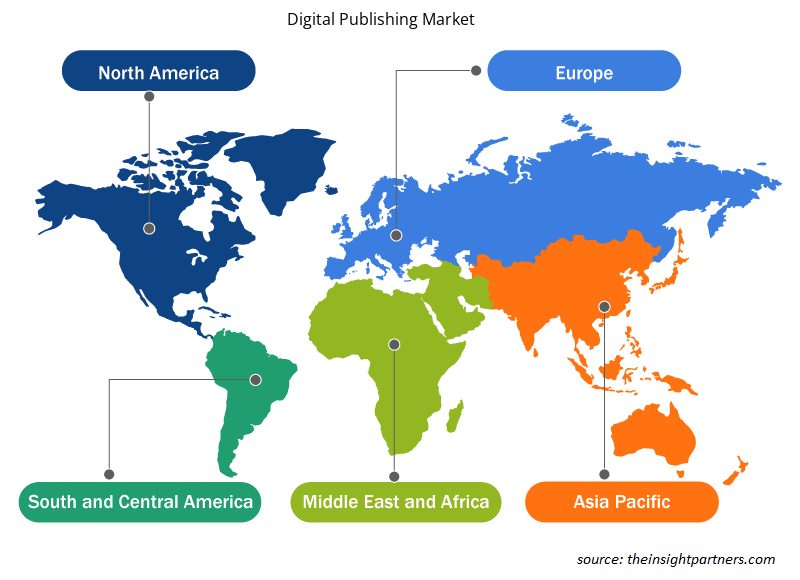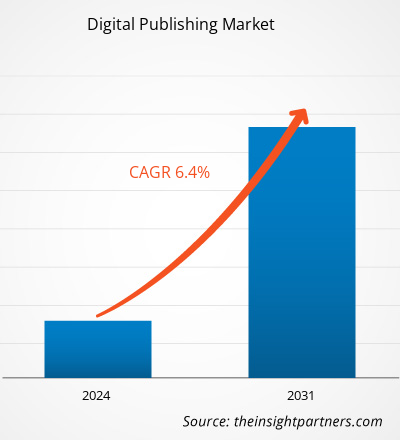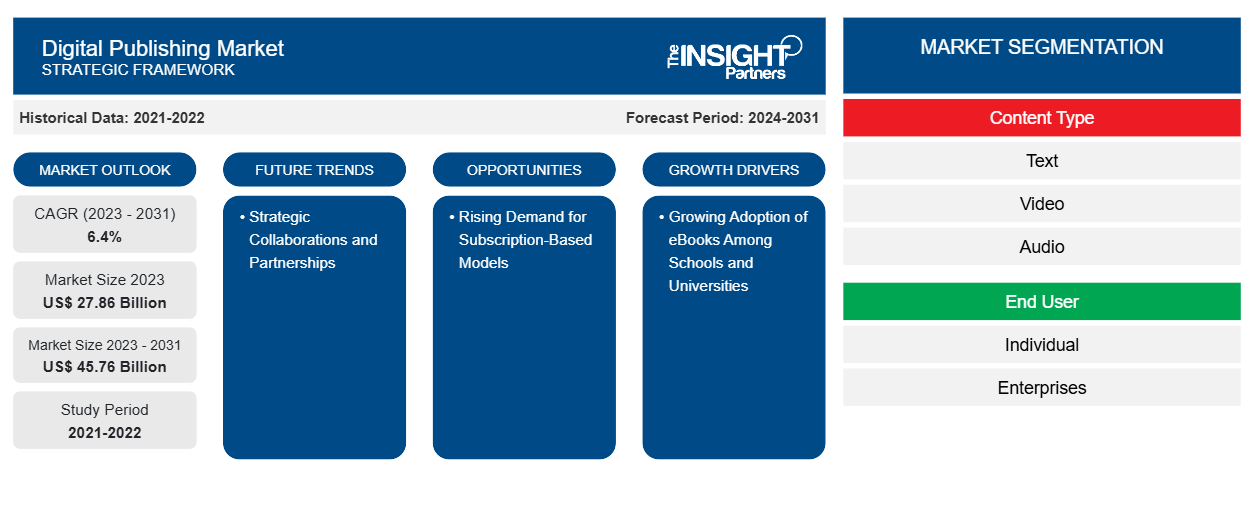من المتوقع أن يصل حجم سوق النشر الرقمي إلى 45.76 مليار دولار أمريكي بحلول عام 2031 من 27.86 مليار دولار أمريكي في عام 2023. ومن المتوقع أن يسجل السوق معدل نمو سنوي مركب بنسبة 6.4٪ خلال الفترة 2023-2031. ومن المرجح أن تظل التعاونات والشراكات الاستراتيجية اتجاهًا رئيسيًا في السوق.
تحليل سوق النشر الرقمي
إن النشر الرقمي يحل بسرعة محل طريقة النشر المطبوع التقليدية. وعلاوة على ذلك، فقد أدى جائحة كوفيد-19 أيضًا إلى زيادة الوسائط الرقمية جنبًا إلى جنب مع عوامل أخرى تعزز نمو النشر الرقمي. يعمل الناشرون بسرعة على زيادة التوزيع وتوسيع مصادر إيراداتهم الحالية من خلال اختيار النشر الرقمي. بالإضافة إلى العوامل المذكورة أعلاه، هناك العديد من ميزات النشر الرقمي الجديدة التي من المتوقع أن تؤثر على نمو النشر الرقمي في السنوات الست إلى السبع القادمة. على سبيل المثال، فإن التوثيق وبساطة تنفيذ المنتج، بالإضافة إلى الأداء وتجربة المستخدم التي يمكن الوصول إليها بسرعة وسهولة، تدفع الحاجة إلى المحتوى الأصلي أو المحتوى الذي ينشئه المستخدم للاحتفاظ بالمستخدمين، وتحقيق الدخل من المحتوى، ودمج التجارة الإلكترونية.
نظرة عامة على سوق النشر الرقمي
يتضمن النشر الرقمي، المعروف بالنشر الإلكتروني أو عبر الإنترنت، نشر محتوى مختلف عبر الإنترنت مثل الدوريات والمجلات والصحف والكتب الإلكترونية. من خلال اتباع هذه العملية، يمكن لأي شركة أو كيان نشر تحويل المستندات والبيانات الورقية إلى تنسيق رقمي، يمكن الوصول إليه عبر الإنترنت وتنزيله وتحريره وطباعته أو مشاركته وفقًا لتقدير المستخدمين.
قم بتخصيص هذا التقرير ليناسب متطلباتك
ستحصل على تخصيص لأي تقرير - مجانًا - بما في ذلك أجزاء من هذا التقرير، أو تحليل على مستوى الدولة، وحزمة بيانات Excel، بالإضافة إلى الاستفادة من العروض والخصومات الرائعة للشركات الناشئة والجامعات
-
احصل على أهم اتجاهات السوق الرئيسية لهذا التقرير.ستتضمن هذه العينة المجانية تحليلاً للبيانات، بدءًا من اتجاهات السوق وحتى التقديرات والتوقعات.
محركات وفرص سوق النشر الرقمي
تزايد استخدام الكتب الإلكترونية بين المدارس والجامعات لصالح السوق
تدعم الكتب الإلكترونية المؤسسات التعليمية في تحقيق ثلاثة أهداف استراتيجية رئيسية: تعزيز تجربة الطلاب والإنجازات الأكاديمية في بيئة أكثر تنافسية، وتعزيز الابتكار في التدريس والتعلم والبحث، والمساعدة في الاستخدام الأمثل للموارد المكانية والبشرية. بالنسبة للجامعات ومكتباتها، كانت هناك مشكلة قائمة منذ فترة طويلة تتمثل في ضمان توافر الكتب المهمة في الوقت المناسب، وكانت الشكوى الأساسية في استطلاعات الطلاب غالبًا هي العدد غير الكافي من النسخ. يمكن للطلاب الوصول بسهولة إلى الكتب الإلكترونية في أي وقت ومن أي مكان، مما يجعلها خيارًا مناسبًا يتماشى مع توقعاتهم بطريقة أكثر كفاءة.
علاوة على ذلك، فإن التقدم المتزايد في التعليم والتدريب والاستكشاف يؤثر على الإقبال العالمي على النشر الرقمي. على سبيل المثال، تقدم جامعة ليستر درجة الماجستير في الأمن والصراع والتنمية الدولية من خلال التعلم عبر الإنترنت. يقدم قسم علم الإجرام برنامجًا مصممًا خصيصًا للأفراد في قطاع التنمية الدولية أو الطامحين إلى العمل فيه. يمكن للطلاب في هذا البرنامج العمل في أماكن عسكرية أو مناطق نائية أو كقوات حفظ سلام، بعيدًا عن بيئة الفصول الدراسية النموذجية. يتلقى كل طالب جهاز iPad يحتوي على مواد الدورة والكتب الإلكترونية وتطبيق الدورة للوصول. يمكن للطلاب الوصول إلى هذه الكتب الإلكترونية وقراءتها حتى عندما يفتقر مكان عملهم إلى اتصال إنترنت موثوق به، والذي قد يكون غالبًا غير متاح أو غير موثوق به. إن الاستخدام المتزايد للكتب الإلكترونية في المؤسسات التعليمية يدفع توسع صناعة النشر الرقمي في جميع أنحاء العالم.
ارتفاع الطلب على النماذج القائمة على الاشتراك
تتطلب البيئة الإلكترونية المتغيرة المرونة، مما يدفع الناشرين إلى تنويع مصادر دخلهم. وهم يبحثون عن طرق جديدة لضمان الاستقرار المالي، والتوسع خارج نماذج الإعلان والاشتراك المعتادة. وتُرى هذه الاستراتيجية الجديدة بطرق مختلفة: من خلال شراكات المحتوى المدعوم، حيث تعمل العلامات التجارية معًا على محتوى ذي صلة، أو التسويق بالعمولة، حيث يكسب الناشرون المال من خلال تسويق المنتجات أو الخدمات وكسب العمولات. كما يوفر تنظيم الأحداث أو إنشاء الدورات التدريبية عبر الإنترنت طرقًا مباشرة للتفاعل مع القراء. إنه يخلق رابطًا أعمق وإمكانية الحصول على المزيد من الدخل. يعيد الناشرون تقييم أساليبهم الحالية، بهدف تخصيص وتلبية احتياجات المستخدمين الأفراد. تتيح المدفوعات الصغيرة، التي أصبحت شائعة بشكل متزايد، للقراء دفع رسوم صغيرة مقابل مقالات فردية بدلاً من الالتزام بخدمات الاشتراك الكاملة، مما يوفر المزيد من المرونة ويلبي عادات الاستهلاك المتنوعة.
تقرير تحليل تجزئة سوق النشر الرقمي
إن القطاعات الرئيسية التي ساهمت في استنتاج تحليل سوق النشر الرقمي هي نوع المحتوى والمستخدم النهائي.
- بناءً على نوع المحتوى، يتم تقسيم السوق إلى نصوص وفيديو وصوت. احتل قطاع الفيديو حصة سوقية كبيرة في عام 2023.
- من حيث المستخدم النهائي، ينقسم السوق إلى أفراد ومؤسسات. وقد استحوذ القطاع الفردي على حصة كبيرة من السوق في عام 2023.
تحليل حصة سوق النشر الرقمي حسب المنطقة الجغرافية
ينقسم النطاق الجغرافي لتقرير سوق النشر الرقمي بشكل أساسي إلى خمس مناطق: أمريكا الشمالية، ومنطقة آسيا والمحيط الهادئ، وأوروبا، والشرق الأوسط وأفريقيا، وأمريكا الجنوبية والوسطى.
من المتوقع أن تستحوذ أمريكا الشمالية على حصة كبيرة في سوق النشر الرقمي في عام 2023. والزيادة المتوقعة في الطلب على سوق النشر الرقمي في هذه المنطقة مدفوعة بالحاجة المتزايدة إلى منشورات رقمية محسنة. وتشارك شركات رائدة في السوق مثل Adobe Inc. وApple Inc. وAmazon.com Inc. وAlphabet Inc. وغيرها في شراكات وعمليات استحواذ وتطوير منتجات وتحسينات جديدة، مما يدفع نمو السوق في المنطقة. ومن الأمثلة على ذلك عندما كشفت Comcast Inc. عن حل جديد في مارس 2021 للاتصال بإدارة الحملات الإعلانية المركزية للتلفزيون.
رؤى إقليمية حول سوق النشر الرقمي
لقد قام المحللون في Insight Partners بشرح الاتجاهات والعوامل الإقليمية المؤثرة على سوق النشر الرقمي طوال فترة التوقعات بشكل شامل. يناقش هذا القسم أيضًا قطاعات سوق النشر الرقمي والجغرافيا في جميع أنحاء أمريكا الشمالية وأوروبا ومنطقة آسيا والمحيط الهادئ والشرق الأوسط وأفريقيا وأمريكا الجنوبية والوسطى.

- احصل على البيانات الإقليمية المحددة لسوق النشر الرقمي
نطاق تقرير سوق النشر الرقمي
| سمة التقرير | تفاصيل |
|---|---|
| حجم السوق في عام 2023 | 27.86 مليار دولار أمريكي |
| حجم السوق بحلول عام 2031 | 45.76 مليار دولار أمريكي |
| معدل النمو السنوي المركب العالمي (2023 - 2031) | 6.4% |
| البيانات التاريخية | 2021-2022 |
| فترة التنبؤ | 2024-2031 |
| القطاعات المغطاة |
حسب نوع المحتوى
|
| المناطق والدول المغطاة |
أمريكا الشمالية
|
| قادة السوق وملفات تعريف الشركات الرئيسية |
|
كثافة اللاعبين في سوق النشر الرقمي: فهم تأثيرها على ديناميكيات الأعمال
يشهد سوق النشر الرقمي نموًا سريعًا، مدفوعًا بالطلب المتزايد من المستخدم النهائي بسبب عوامل مثل تفضيلات المستهلكين المتطورة والتقدم التكنولوجي والوعي المتزايد بفوائد المنتج. ومع ارتفاع الطلب، تعمل الشركات على توسيع عروضها والابتكار لتلبية احتياجات المستهلكين والاستفادة من الاتجاهات الناشئة، مما يؤدي إلى زيادة نمو السوق.
تشير كثافة اللاعبين في السوق إلى توزيع الشركات أو المؤسسات العاملة في سوق أو صناعة معينة. وهي تشير إلى عدد المنافسين (اللاعبين في السوق) الموجودين في مساحة سوق معينة نسبة إلى حجمها أو قيمتها السوقية الإجمالية.
الشركات الرئيسية العاملة في سوق النشر الرقمي هي:
- هوريكس ديجيتال
- فيجوا
- فيتالسورس تكنولوجيز
- تقنيات إكسلسوفت
- شركة إمبيلسيس
- إيسوو
إخلاء المسؤولية : الشركات المذكورة أعلاه ليست مرتبة بأي ترتيب معين.

- احصل على نظرة عامة على أهم اللاعبين الرئيسيين في سوق النشر الرقمي
أخبار سوق النشر الرقمي والتطورات الأخيرة
يتم تقييم سوق النشر الرقمي من خلال جمع البيانات النوعية والكمية بعد البحث الأولي والثانوي، والتي تتضمن منشورات الشركات المهمة وبيانات الجمعيات وقواعد البيانات. فيما يلي بعض التطورات في سوق النشر الرقمي:
- تقدم FlipHTML5 أداة إنشاء الكتب الإلكترونية المبتكرة التي تعمل بالذكاء الاصطناعي، والتي تعمل على إحداث ثورة في صناعة النشر الرقمي. تعمل هذه الأداة المتقدمة على تبسيط إنشاء الكتب الإلكترونية، مما يتيح للمستخدمين إنتاج كتب إلكترونية احترافية وتفاعلية بسلاسة.
(المصدر: PR UNDERGROUND، بيان صحفي، يونيو 2024)
- في خطوة جريئة لتعزيز قدرات الناشرين والمبدعين الرقميين، أطلقت شركة Ezoic للتو برنامج Enterprise الذي طال انتظاره. تم تصميم هذا البرنامج الشامل من الخدمات والميزات خصيصًا للمبدعين على مستوى المؤسسات، وهو يمثل توسعًا كبيرًا في عروض Ezoic، حيث يوفر حلولاً مخصصة لتلبية الاحتياجات الفريدة للناشرين والمبدعين الرقميين على نطاق واسع.
(المصدر: موقع شركة Ezoic الإلكتروني، مارس 2023)
تغطية تقرير سوق النشر الرقمي والمنتجات النهائية
يوفر تقرير "حجم سوق النشر الرقمي والتوقعات (2021-2031)" تحليلاً مفصلاً للسوق يغطي المجالات التالية:
- حجم سوق النشر الرقمي وتوقعاته على المستويات العالمية والإقليمية والوطنية لجميع قطاعات السوق الرئيسية التي يغطيها النطاق
- اتجاهات سوق النشر الرقمي بالإضافة إلى ديناميكيات السوق مثل المحركات والقيود والفرص الرئيسية
- تحليل مفصل لقوى PEST/Porter الخمس وSWOT
- تحليل سوق النشر الرقمي الذي يغطي اتجاهات السوق الرئيسية والإطار العالمي والإقليمي والجهات الفاعلة الرئيسية واللوائح والتطورات الأخيرة في السوق
- تحليل المشهد الصناعي والمنافسة الذي يغطي تركيز السوق، وتحليل خريطة الحرارة، واللاعبين البارزين، والتطورات الأخيرة لسوق النشر الرقمي
- ملفات تعريف الشركة التفصيلية
- التحليل التاريخي (سنتان)، سنة الأساس، التوقعات (7 سنوات) مع معدل النمو السنوي المركب
- تحليل PEST و SWOT
- حجم السوق والقيمة / الحجم - عالمي، إقليمي، بلد
- الصناعة والمنافسة
- مجموعة بيانات إكسل
التقارير الحديثة
تقارير ذات صلة
شهادات العملاء
سبب الشراء
- اتخاذ قرارات مدروسة
- فهم ديناميكيات السوق
- تحليل المنافسة
- رؤى العملاء
- توقعات السوق
- تخفيف المخاطر
- التخطيط الاستراتيجي
- مبررات الاستثمار
- تحديد الأسواق الناشئة
- تحسين استراتيجيات التسويق
- تعزيز الكفاءة التشغيلية
- مواكبة التوجهات التنظيمية























 احصل على عينة مجانية ل - سوق النشر الرقمي
احصل على عينة مجانية ل - سوق النشر الرقمي